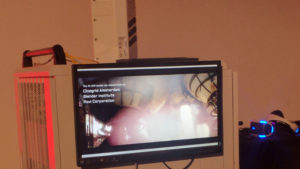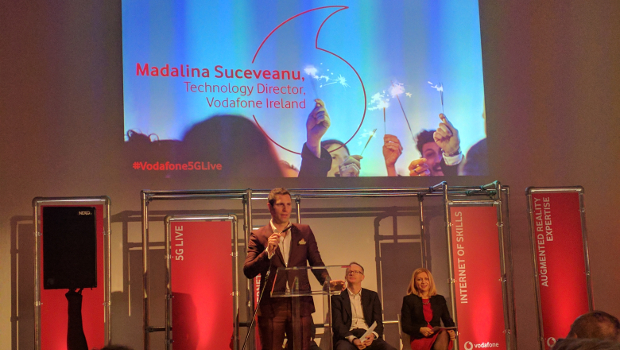Vodafone Ireland and Ericsson have demonstrated pre-standard 5G technologies with speeds of more than 14Gb/s at an event in the Trinity’s Douglas Hyde Gallery.
In testing, speeds exceeding 15Gb/s have been achieved, said Vodafone, with latency of less than 5ms. The company said it had also tested the pre-standard 5G across its recently acquired 3.6GHz spectrum.
Madalina Suceveanu, chief technology officer, Vodafone Ireland said the key features of 5G would be speed, scalability, reliability and low latency, enabling enhancements of services and user experience that were simply not possible previously.
There will be “enhanced user experience like never before,” said Suceveanu, with the technology “bringing augmented reality (AR) and virtual reality (VR) content to customers in Ireland.”

A live stream of 4K video over 5G at 14.2 GB/s in Trinity’s Douglas Hyde Gallery. (Image: Mediateam)
Demonstrations
Vodafone demonstrated various use cases for 5G, from streaming 4K video to a mobile device to the Internet of Skills and connected cars in a smart city environment.
Suceveanu said that 5G would “greatly complement Internet of Things (IoT)” technologies, providing connectivity for a far greater number of devices than would have been possible with current technologies.
Vodafone expects 5G to be available “within 24 months,” said Suceveanu.
Current wired and wireless technologies have connected people, devices and places, said Steve Allen, head of network strategy, Ericsson, but the “5G era will connect everything else”.
“Expect 5G services to be revolutionary,” said Allen, but the technology is “evolutionary”. This means 5G roll out will be highly efficient, as it can build on 4G services and employ the same backhaul, core facilities and technologies.
Layered technologies
Having implemented fibre and microwave band backhaul over the last few years, latency has been improved across the board and network virtualisation has paved the way to take full advantage of 5G, said Allen. This includes being able to tailor network services to individual users, organisations or classifications of traffic. For example, a remotely controlled robot needs a far higher level of bandwidth and latency than most other applications and can be prioritised with the kind of segmentation and layering now possible with network virtualisation and 5G infrastructure.
5G is more flexible and adaptable, said Allen, and is expected to be here, once implemented, for 10 or more years during which time its capabilities will develop.
He said it is already in use, such as in the Korean Winter Olympics where it will support broadcast services.
Current 5G usage tends to be in the lower frequency bands, such as here where the 3.6GHz frequencies are used, but future services will use microwave band and all the way up to 7GHz.
Beam techniques
Hans Hammar, global programme director, Ericsson, detailed how 5G uses active antenna technology, in common with 4G, but goes further with techniques such as beam forming and beam steering to deliver single-user and multi-user multiple-input and multiple-output (MIMO) that can improve coverage, as well as significant capacity gain.
Hammar said that 5G would be expected to provide up to six times the coverage of current technologies. The cost per device is also coming down, and this will have an affect on everything from narrow band IoT to the number of devices that can be facilitated on networks.
Ericsson has engaged with various industries, said Hammar, to gauge what their needs and use cases might be. What emerged were projects for self-driving buses in Stockholm to a wireless factory for bearing maker SKF.
Emerging standards
With December of 2017 seeing the first 5G standards set by 3GPP, Hammar said we are “on the doorstep of commercialised 5G”. Other applications are now emerging, and Vodafone provided demonstrations of some.
The media will be a consumer of super-high speed broadband, supporting increasing traffic demands from video services and interactive applications such as 4K streaming, video analytics and holograms.
There will be the ability to connect massive numbers of devices, said Vodafone, as the exponential growth of connected IoT devices is driving more and more use cases, such as smart vehicles (from asset tracking and remote monitoring, to Vehicle to Everything), with the next generation network needing to provide a reliable response to billions of devices.
5G will provide faster, secure, reliable and robust connectivity which is essential, said Vodafone, for delivering mission critical services such as real-time video surveillance, self-driving cars, eHealth remote surgery and remote patient monitoring.
The technology will provide ultra-low latency for human machine interaction, for example, supporting real time response requirements that allow virtual reality, augmented reality and real-time control of robotics, such as in surgery.
Successful trials
“This first successful trial of pre-standard 5G,” said Suceveanu, “is an essential step forward in achieving our vision of a Gigabit Society for Ireland. As our network evolves toward 5G it will become even faster and more resilient, will have significantly lower latency, and will allow a huge number of devices to connect simultaneously.”
“Vodafone Ireland’s path to 5G will build on the great foundation of our advanced 4G network and will enhance and complement our recently launched NB-IoT network that will support the growth of the Internet of Things.”
TechCentral Reporters








Subscribers 0
Fans 0
Followers 0
Followers